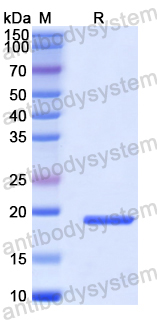Catalog No.
YHK92801
Expression system
E. coli
Species
Homo sapiens (Human)
Protein length
Arg231-Val289
Predicted molecular weight
19.24 kDa
Nature
Recombinant
Endotoxin level
Please contact with the lab for this information.
Purity
>90% as determined by SDS-PAGE.
Accession
Q9HA38
Applications
ELISA, Immunogen, SDS-PAGE, WB, Bioactivity testing in progress
Form
Lyophilized
Storage buffer
Lyophilized from a solution in PBS pH 7.4, 0.02% NLS, 1mM EDTA, 4% Trehalose, 1% Mannitol.
Reconstitution
Reconstitute in sterile water for a stock solution. A copy of datasheet will be provided with the products, please refer to it for details.
Shipping
In general, proteins are provided as lyophilized powder/frozen liquid. They are shipped out with dry ice/blue ice unless customers require otherwise.
Stability and Storage
Use a manual defrost freezer and avoid repeated freeze thaw cycles. Store at 2 to 8°C for frequent use. Store at -20 to -80°C for twelve months from the date of receipt.
Alternative Names
PAG608, Zinc finger matrin-type protein 3, ZMAT3, p53-activated gene 608 protein, Zinc finger protein WIG-1, WIG1
p53-induced RNA-binding protein ZMAT3 inhibits transcription of a hexokinase to suppress mitochondrial respiration., PMID:40391325
ATXN2L primarily interacts with NUFIP2, the absence of ATXN2L results in NUFIP2 depletion, and the ATXN2-polyQ expansion triggers NUFIP2 accumulation., PMID:40220918
FN1 shapes the behavior of papillary thyroid carcinoma through alternative splicing of EDB region., PMID:39747903
Identification of BBC3 as a novel indicator for predicting prostate cancer development and olaparib resistance., PMID:39331229
Upregulation of ZMAT3 is Associated with the Poor Prognosis of Breast Cancer., PMID:39286533
The ribosomal protein L22 binds the MDM4 pre-mRNA and promotes exon skipping to activate p53 upon nucleolar stress., PMID:39116201
ZMAT3 participated in benzene-caused disruption in self-renewal and differentiation of hematopoietic stem cells via TNF-α/NF-κB pathway., PMID:38914192
Elucidating the chain of command: our current understanding of critical target genes for p53-mediated tumor suppression., PMID:38661126
Combined absence of TRP53 target genes ZMAT3, PUMA and p21 cause a high incidence of cancer in mice., PMID:38110554
Altered H3K4me3 profile at the TFAM promoter causes mitochondrial alterations in preadipocytes from first-degree relatives of type 2 diabetics., PMID:37679776
Papillary Thyroid Carcinoma: A thorough Bioinformatic Analysis of Gene Expression and Clinical Data., PMID:37372430
Adaptive resistance is not responsible for long-term drug resistance in a cellular model of triple negative breast cancer., PMID:36195266
Craniofacial Defects in Embryos with Homozygous Deletion of Eftud2 in Their Neural Crest Cells Are Not Rescued by Trp53 Deletion., PMID:36012294
Transcriptomic and network pharmacology approaches revealed possible mechanisms underlying the 5-fluorouracil (5-FU)-sensitizing effect of Xuan-Fu-Hua decoction treatment on liver cancer cells., PMID:35966306
Genome-wide association study of SARS-CoV-2 infection in Chinese population., PMID:35927536
High Expression of UPK3A Promotes the Progression of Gastric Cancer Cells by Inactivating p53 Pathway., PMID:35774082
Integrative RNA profiling of TBEV-infected neurons and astrocytes reveals potential pathogenic effectors., PMID:35685361
ZMAT3 hypomethylation contributes to early senescence of preadipocytes from healthy first-degree relatives of type 2 diabetics., PMID:35146866
eIF5B regulates the expression of PD-L1 in prostate cancer cells by interacting with Wig1., PMID:34525951
Zmat3 splices together p53-dependent tumor suppression., PMID:34027039
Impact of human rhinoviruses on gene expression in pediatric patients with severe acute respiratory infection., PMID:33878402
Long Non-Coding RNA Landscape in Prostate Cancer Molecular Subtypes: A Feature Selection Approach., PMID:33672425
The p53-induced RNA-binding protein ZMAT3 is a splicing regulator that inhibits the splicing of oncogenic CD44 variants in colorectal carcinoma., PMID:33334821
Zmat3 Is a Key Splicing Regulator in the p53 Tumor Suppression Program., PMID:33157015
Consequences of Zmat3 loss in c-MYC- and mutant KRAS-driven tumorigenesis., PMID:33082333
Nuclear Respiratory Factor 1 (NRF1) Transcriptional Activity-Driven Gene Signature Association with Severity of Astrocytoma and Poor Prognosis of Glioblastoma., PMID:32594352
SMARCD1 is a transcriptional target of specific non-hotspot mutant p53 forms., PMID:31637714
Transcriptome sequencing profiles of cervical cancer tissues and SiHa cells., PMID:31456134
Pro-apoptotic genes as new targets for single and combinatorial treatments with resveratrol and curcumin in colorectal cancer., PMID:31169275
MicroRNA-184 promotes apoptosis of trophoblast cells via targeting WIG1 and induces early spontaneous abortion., PMID:30833572
Identification of Altered Developmental Pathways in Human Juvenile HD iPSC With 71Q and 109Q Using Transcriptome Profiling., PMID:30713489
DNA repair processes are critical mediators of p53-dependent tumor suppression., PMID:29892060
Candidate gene biodosimetry markers of exposure to external ionizing radiation in human blood: A systematic review., PMID:29879226
WIG1 is crucial for AGO2-mediated ACOT7 mRNA silencing via miRNA-dependent and -independent mechanisms., PMID:28472401
Allele-specific regulation of mutant Huntingtin by Wig1, a downstream target of p53., PMID:27206983
Genome-wide identification of Wig-1 mRNA targets by RIP-Seq analysis., PMID:26672765
Expression of the p53 target Wig-1 is associated with HPV status and patient survival in cervical carcinoma., PMID:25379706
Acute L-glutamine deprivation affects the expression of TP53-related protein genes in U87 glioma cells., PMID:25335230
Wig-1 regulates cell cycle arrest and cell death through the p53 targets FAS and 14-3-3σ., PMID:24469038
Effects of TP53 mutational status on gene expression patterns across 10 human cancer types., PMID:24374933
Mutant p53 attenuates the anti-tumorigenic activity of fibroblasts-secreted interferon beta., PMID:23630584
Wig1 prevents cellular senescence by regulating p21 mRNA decay through control of RISC recruitment., PMID:23085987
Effect of altered WIG-1 expression on DDP sensitivity in a DDP-resistant esophageal squamous cancer cell line., PMID:22794122
Gene network analyses of first service conception in Brangus heifers: use of genome and trait associations, hypothalamic-transcriptome information, and transcription factors., PMID:22739780
Wig-1, a novel regulator of N-Myc mRNA and N-Myc-driven tumor growth., PMID:22513872
Genomic analysis of wig-1 pathways., PMID:22347364
An eQTL-based method identifies CTTN and ZMAT3 as pemetrexed susceptibility markers., PMID:22171072
Zinc induces cell cycle arrest and apoptosis by upregulation of WIG-1 in esophageal squamous cancer cell line EC109., PMID:21559779
The p53 target Wig-1: a regulator of mRNA stability and stem cell fate?, PMID:21394102
Preparation of a novel monoclonal antibody specific for WIG-1 and detection of its expression pattern in human esophageal carcinoma., PMID:21050045

